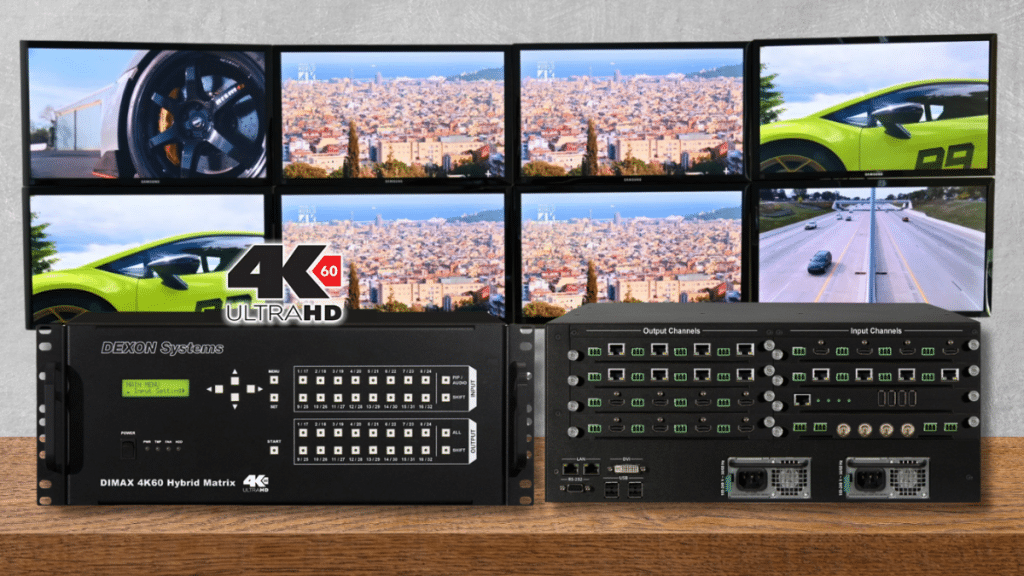When we walk into a shopping mall, airport, or high-end conference hall, our eyes are immediately drawn to the bright digital screens, high-definition visuals, and engaging multimedia content. Whether it’s flight schedules, advertisements, or live presentations, it all seems to appear effortlessly. But behind these smooth visual experiences lies a world of advanced technology working quietly in the background. At the center of it all is one of the most underappreciated yet essential tools: the matrix switcher.
What Is a Matrix Switcher and Why Does It Matter?
A matrix switcher is a device that allows multiple video (and sometimes audio) sources to be routed to multiple displays at the same time — instantly and accurately. In simple words, it’s like a central brain that decides which content goes where, and when.
Let’s say you have 10 video sources (like a CCTV feed, presentation, live TV, digital signage, etc.) and 15 displays. Instead of manually switching wires or running each source to each screen individually — which would be a nightmare — a matrix switcher makes this seamless. With just a few clicks, it can send a video feed from Source A to Screens 1, 3, and 5, and Source B to Screens 2 and 4, all without any delay or disruption.
Where You’ve Already Seen Matrix Switchers in Action
Even if you’ve never heard of matrix switchers before, you’ve almost certainly benefited from them. Here’s how they power some of the most common public and professional environments:
1. Airports
Digital flight information boards, security camera feeds, advertising panels, and emergency alert systems all depend on coordinated AV distribution. Matrix switchers make it possible to switch between feeds instantly — critical when flights are delayed or emergency messages need to be shown across all terminals at once.
2. Shopping Malls
From dynamic storefront promotions to centralized advertising screens, malls use matrix switchers to control hundreds of displays across different floors and zones — all from a central control room.
3. Conference Halls and Meeting Rooms
In large corporate events or hybrid conferences, there may be several presenters, each with different content. Matrix switchers allow operators to switch between laptops, video feeds, or even remote Zoom inputs, sending the right content to the right screen without any awkward delays.
4. Control Rooms
Police departments, transport authorities, and utility control centers rely on real-time monitoring. Matrix switchers enable operators to view and rearrange camera feeds across multiple large video walls in seconds.
Key Benefits of Matrix Switchers
Matrix switchers offer several advantages that make them essential in modern AV infrastructure:
- Real-Time Switching: There’s no buffering or waiting. Inputs are routed to outputs instantly, which is especially critical in time-sensitive environments like control rooms or live events.
- Centralized Management: Instead of managing each display separately, everything can be controlled from one interface, saving time and reducing human error.
- Supports High-Resolution Formats: Most modern matrix switchers support 4K and even 8K, ensuring content quality is never compromised — even across large display networks.
- Seamless Integration: They are compatible with other AV gear — like media servers, video walls, streaming devices, and even IP-based surveillance systems.
- System Reliability & Failover Support: Many high-end models now come with redundancy features — such as dual power supplies or backup switching paths — to ensure that even if one part fails, the system continues to work without disruption.
- IP Camera Decoding: As more AV systems move to IP-based formats, matrix switchers now often include IP decoding functions — reducing the need for additional devices and simplifying installation.
Meeting the Demands of Modern AV
As digital content becomes more advanced and dynamic, users expect smooth, responsive, and high-quality delivery. This has pushed AV systems to evolve rapidly. Today, system integrators are looking for solutions that are:
- Fast: Content must switch instantly — no black screens, no lag.
- Reliable: Especially in critical environments, downtime is not acceptable.
- Scalable: AV networks need to grow over time. Matrix switchers make this easier.
- User-friendly: Operators, even those without technical backgrounds, should be able to use the system without extensive training.
Matrix switchers tick all these boxes. They are designed to handle today’s content demands while being future-ready.
A Quiet, Yet Powerful Player
You may never actually see a matrix switcher while visiting a venue — they’re usually tucked away in a rack room or control center. But without them, the entire multi-display experience would fall apart. No other device provides the same level of control, reliability, and flexibility.
Think of matrix switchers as the traffic controllers of your AV network, silently directing content to the right screens with military precision.
Conclusion: The Backbone of Seamless Visual Experiences
In a world where digital content is everywhere, delivering that content correctly — and beautifully — matters more than ever. Matrix switchers are the unsung heroes that make this possible. From airports and malls to conference halls and control rooms, they ensure that visuals and data are always in the right place, at the right time.
So the next time you admire a crisp screen at a public venue or smoothly switch slides during a high-stakes meeting, remember — there’s a matrix switcher quietly working behind the scenes to make it all happen.

